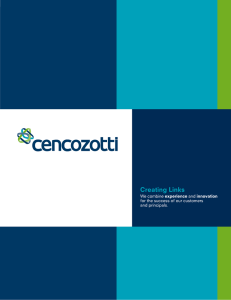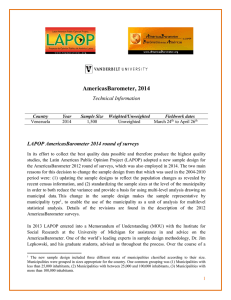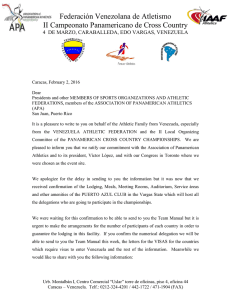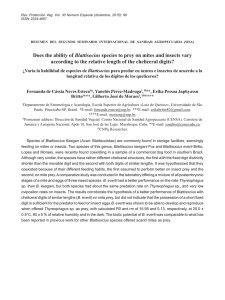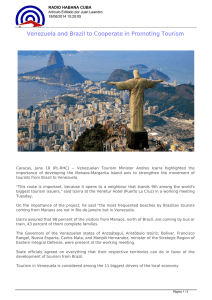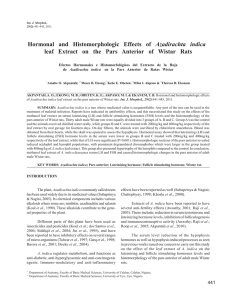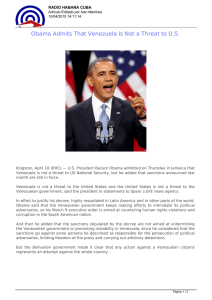First Report of Raoiella indica Hirst (Acari: Tenuipalpidae) in South
Anuncio
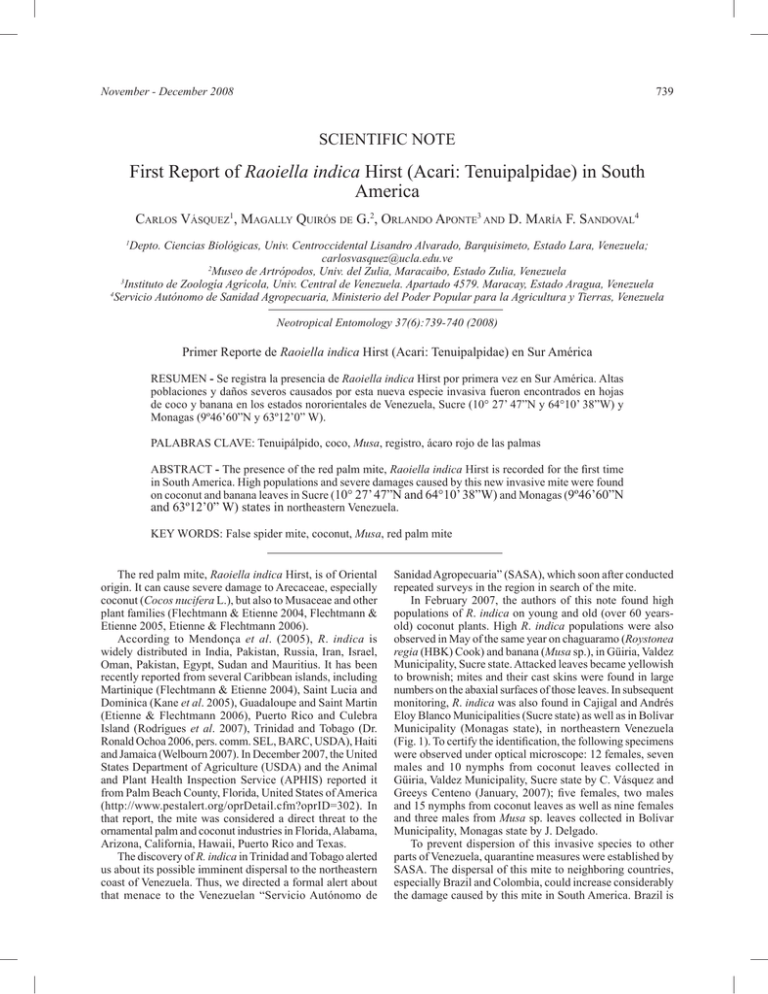
November - December 2008 739 SCIENTIFIC NOTE First Report of Raoiella indica Hirst (Acari: Tenuipalpidae) in South America CARLOS VÁSQUEZ1, MAGALLY QUIRÓS DE G.2, ORLANDO APONTE3 AND D. MARÍA F. SANDOVAL4 Depto. Ciencias Biológicas, Univ. Centroccidental Lisandro Alvarado, Barquisimeto, Estado Lara, Venezuela; carlosvasquez@ucla.edu.ve 2 Museo de Artrópodos, Univ. del Zulia, Maracaibo, Estado Zulia, Venezuela 3 Instituto de Zoología Agrícola, Univ. Central de Venezuela. Apartado 4579. Maracay, Estado Aragua, Venezuela 4 Servicio Autónomo de Sanidad Agropecuaria, Ministerio del Poder Popular para la Agricultura y Tierras, Venezuela 1 Neotropical Entomology 37(6):739-740 (2008) Primer Reporte de Raoiella indica Hirst (Acari: Tenuipalpidae) en Sur América RESUMEN - Se registra la presencia de Raoiella indica Hirst por primera vez en Sur América. Altas poblaciones y daños severos causados por esta nueva especie invasiva fueron encontrados en hojas de coco y banana en los estados nororientales de Venezuela, Sucre (10° 27’ 47”N y 64°10’ 38”W) y Monagas (9º46’60”N y 63º12’0” W). PALABRAS CLAVE: Tenuipálpido, coco, Musa, registro, ácaro rojo de las palmas ABSTRACT - The presence of the red palm mite, Raoiella indica Hirst is recorded for the first time in South America. High populations and severe damages caused by this new invasive mite were found on coconut and banana leaves in Sucre (10° 27’ 47”N and 64°10’ 38”W) and Monagas (9º46’60”N and 63º12’0” W) states in northeastern Venezuela. KEY WORDS: False spider mite, coconut, Musa, red palm mite The red palm mite, Raoiella indica Hirst, is of Oriental origin. It can cause severe damage to Arecaceae, especially coconut (Cocos nucifera L.), but also to Musaceae and other plant families (Flechtmann & Etienne 2004, Flechtmann & Etienne 2005, Etienne & Flechtmann 2006). According to Mendonça et al. (2005), R. indica is widely distributed in India, Pakistan, Russia, Iran, Israel, Oman, Pakistan, Egypt, Sudan and Mauritius. It has been recently reported from several Caribbean islands, including Martinique (Flechtmann & Etienne 2004), Saint Lucia and Dominica (Kane et al. 2005), Guadaloupe and Saint Martin (Etienne & Flechtmann 2006), Puerto Rico and Culebra Island (Rodrígues et al. 2007), Trinidad and Tobago (Dr. Ronald Ochoa 2006, pers. comm. SEL, BARC, USDA), Haiti and Jamaica (Welbourn 2007). In December 2007, the United States Department of Agriculture (USDA) and the Animal and Plant Health Inspection Service (APHIS) reported it from Palm Beach County, Florida, United States of America (http://www.pestalert.org/oprDetail.cfm?oprID=302). In that report, the mite was considered a direct threat to the ornamental palm and coconut industries in Florida, Alabama, Arizona, California, Hawaii, Puerto Rico and Texas. The discovery of R. indica in Trinidad and Tobago alerted us about its possible imminent dispersal to the northeastern coast of Venezuela. Thus, we directed a formal alert about that menace to the Venezuelan “Servicio Autónomo de Sanidad Agropecuaria” (SASA), which soon after conducted repeated surveys in the region in search of the mite. In February 2007, the authors of this note found high populations of R. indica on young and old (over 60 yearsold) coconut plants. High R. indica populations were also observed in May of the same year on chaguaramo (Roystonea regia (HBK) Cook) and banana (Musa sp.), in Güiria, Valdez Municipality, Sucre state. Attacked leaves became yellowish to brownish; mites and their cast skins were found in large numbers on the abaxial surfaces of those leaves. In subsequent monitoring, R. indica was also found in Cajigal and Andrés Eloy Blanco Municipalities (Sucre state) as well as in Bolívar Municipality (Monagas state), in northeastern Venezuela (Fig. 1). To certify the identification, the following specimens were observed under optical microscope: 12 females, seven males and 10 nymphs from coconut leaves collected in Güiria, Valdez Municipality, Sucre state by C. Vásquez and Greeys Centeno (January, 2007); five females, two males and 15 nymphs from coconut leaves as well as nine females and three males from Musa sp. leaves collected in Bolívar Municipality, Monagas state by J. Delgado. To prevent dispersion of this invasive species to other parts of Venezuela, quarantine measures were established by SASA. The dispersal of this mite to neighboring countries, especially Brazil and Colombia, could increase considerably the damage caused by this mite in South America. Brazil is 740 Vásquez et al. - First Report of Raoiella indica Hirst (Acari: Tenuipalpidae) in South America Los Frailes NUEVA ESPARTA MAR CARIBE Cagigal Yaguaraparo Municipality CUMANÁ AndrésEloy Blanco Municipality Valdéz Guiria Municipality G O L F O D E PAR IA Bolívar Municipality MONAGAS DELTA AMACURO Fig. 1. Distribution of R. indica in northeastern Venezuela. considered the second largest banana producer in the world, with over 500 thousand hectares planted and more than six million tons of bananas produced in a year (FAO 2004). In addition, 284 Arecaceae species, including coconut, are found in Brazil (Lorenzi 1996); this country is the second coconut producer in the American continent (Persley 1992). Colombia is also an important banana producer, with about 1.6 million tons produced in a year (Martínez et al. 2007). Consequently, strict sanitary strategies and legal control should be maintained to prevent dispersion of R. indica to other countries in South America. Acknowledgments To SASA, Ministerio del Poder Popular para la Agricultura y Tierras, for supporting the surveys conducted in the infested areas. References Etienne, J. & C.H.W. Flechtmann. 2006. First record of Raoiella indica (Hirst, 1924) (Acari: Tenuipalpidae) in Guadalupe and Saint Martin, West Indies. Int. J. Acarol., 32: 331-332. FAO. 2004. La economía mundial del banano 1985-2002. Available at: ftp://ftp.fao.org/docrep/fao/007/y5102s/y5102s00.pdf Flechtmann, C.H.W. & J. Etienne. 2004. The red palm mite, Raoiella indica Hirst, a threat to palms in the Americas (Acari: Prostigmata: Tenuipalpidae). Syst. Appl. Acarol. 9: 109-110. Flechtmann, C.H.W. & J. Etienne. 2005. Un nouvel acarien ravageur des palmiers: En Martinique, premier signalement de Raoiella indica pour les Caraïbes. Phytoma, 548: 10-11. Hirst, S. 1924. On some new species of red spider. Annals and magazine of natural history, Ser. 9, 14: 522-527. Kane, E., R. Ochoa, G. Mathurin & E. Erbe. 2005. Raoiella indica Hirst (Acari: Tenuipalpidae): An island-hopping mite pest in the Caribbean. The ESA Annual Meeting and exhibition. Ft. Lauderdale, Florida, USA. Available in: http://www.sel.barc. usda.gov/acari/PDF/Raoiella%20indica-Kane%20et%20al. pdf. Lorenzi, H. 1996. Palmeiras no Brasil: Exóticas e nativas. Nova Odessa, Plantarum, 303p. Martínez G., E. Delgado, R. Pargas, E. Manzanilla & H. Ramírez. 2007. Consideraciones generales sobre la producción y el comercio mundial de banano. I: Producción, exportación e importación. Ceniap Hoy. 13: 1-11. Mendonça, R.S., D. Navia & C.H.W. Flechtmann. 2005. Raoiella indica Hirst (Acari: Prostigamata: Tenuipalpidae), o acaro vermelho das palmeiras: Uma ameaça para as Americas. EMBRAPA, Rec. Genet. Biotec., Documentos 146, 37p. Persley, G.J. 1992. Replanting the tree of life: Towards an international agenda for coconut palm research. Wallingford, CAB International, 156p. Rodríguez, J.C., R. Ochoa & E. Kane. 2007. First report of Raoiella indica Hirst (Acari: Tenuipalpidae) and its damage to coconut palms in Puerto Rico and Culebra Island. Int. J. Acarol. 33: 3-5. Welbourn, C. 2007. Red palm mite Raoiella indica Hirst (Acari: Tenuipalpidae). Florida Department of Agriculture & Consumer Services, Division of Plant Industry. Available in http://www. doacs.state.fl.us/pi/enpp/ento/r.indica.html. Received 18/III/2008. Accepted 02/X/2008.
